 |  |
|---|---|
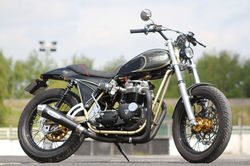 |  |
 |  |
 |  |
 |  |
 |  |
 | 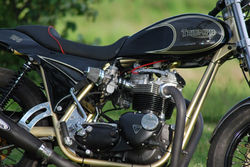 |
 |  |
 |  |
 |  |
 |  |
 |  |
 |  |
 | 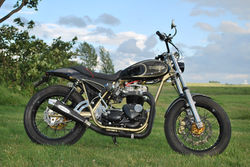 |
 |  |
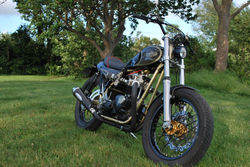 | 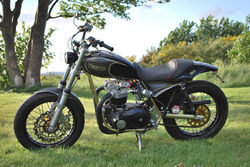 |
 | 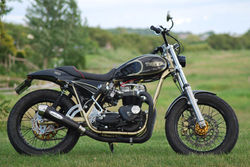 |
 |  |
 |  |
 |  |
 |  |
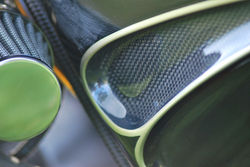 |  |
 |  |
 |  |
 |  |
 |  |
 |  |
 |  |
 |  |
 |  |
 |  |
 |
MRD Freemore Triumph Flat Track Special
Jerry Hutchinson
Motorcyclists are a funny bunch. It’s been said and written that we ride bikes because we don’t like to conform to societal norms. Maybe that was my motivation as a teenager but several key ingredients required to be true non-conformist were missing, including the financial wherewithal, meaningful mechanical ability, and, frankly, any Real idea of how to non-conform beyond merely riding a bike and annoying people with it. Given time, the university of life and experience impart an idea of what non-conformity looks like. There are even those who may be considered non-conforming non-conformists. In a way specials builders fall into this category by not conforming with the norms of motorcycle society. They need greater individuality or room for self expression than “normal” bikers. I became one when I was sated with standard bikes. Or at least mostly standard bikes with a few upgrades like twin disc brakes, electronic ignition, updated suspension and modern tyres. The way it happened was insidious. There was no light bulb moment, but it evolved subconsciously from its ancestry in my teenage years. I modified and tweaked standard bikes, until one day in around 2004 a fully-formed idea to build a special emerged.
Well, I say “fully formed”. It was more of a nebulous desire than fully formed plan. Nevertheless, my subconscious must have been working on it because one day it informed me that I was to build a special based on a Bonneville. I like Triumphs you see. There was a 1973 T120R, light and fun to ride, in the garage already. Financial resources were now more available, but still cost was a consideration and so a pre oil-in-frame donor bike was ruled out. Anyway it felt as if I would be violating something special if I modified one. It was important too that the bike would not attract the attentions of the DVLA for road tax so it needed to be pre-1973 leaving a rather limited choice of Triumphs.
However, this presented a conundrum. I did not want an OIF Bonneville as the basis for the bike. It was not conducive to a lithe and light looking bike with that huge vertical oil tank behind the engine. It is not easily hidden. So the search was on for a chassis that would better suit a special. Metisse was considered, as was a Hyde Harrier. Poles apart! See what I mean about a nebulous plan? I wanted a special but at the time had no vision for it. Off road style? Café racer? Bobber? Thruxton look-alike? The vision was not clear. I needed a light bulb moment.
At the April 2006 Stafford show I happened upon the revelation that sparked the much-needed light bulb moment and gave me the much-needed vision. MRD (Motorcycle Research and Development) Freemore had a stand at the show exhibiting a bike built from their kit. Pretty much all the necessary parts were in the full kit or you could go your own way with the frame and swinging arm configured to take a pre-unit or unit Triumph twin, a BSA Gold Star or a Matchless motor.
The bikes, the brainchildren of Pat French and Chris Loosmore, the owners of MRD Freemore, and John Hall who laid up the bodywork, were based on American flat trackers seen by Pat and Chris at Daytona in 2003. It took, oooh, all of a nanosecond of deeply considered contemplation to know that this was my bike. The MRD Freemore Sunday Morning Special (SMS) with a Bonneville motor beckoned like Lorelei. The SMS has an impeccable pedigree. Pat conceived the frame based on a Harris moto-cross design and sif bronze welded the first few himself using tubes bent by J & T Tubes, Poole. Later frames, mine included, were welded by Marc Jannick, and Chris and John designed the bodywork.
The vision for the bike led to the design philosophy, and once fixed it remained the guiding principle through the project. It had to be light and nimble with plenty of real world torque. It had to be a tasteful and stylish modern classic Triumph with modern chassis components and brakes for today’s road conditions. The Colin Chapman principle of “add lightness” - it’s like free power - was adopted and nothing that does not have to be there was to be fitted. It had to be black with gold highlighting. The motor had to be reliable and make good power, and the electrics and ignition system had to be high quality and modern. The bike had to be built to the highest affordable quality.
Now it didn’t matter one iota what frame the donor machine had, so the first cheap(ish) pre-1973 OIF Bonneville that I found became a target. It was lucky that the 1971 T120R donor bike also came with a motor, albeit seized but with a rather tasty alloy barrel. The identity of the donor would be transferred to the special and all the parts not required were sold. That only left the motor and a disappointingly small pile of cash from the other bits sold off. Truth be told, only parts of the motor ended up in the final machine. Regrettably the seizure had been caused by water and the ARE barrel, already on its largest overbore, was unsalvageable, at least by me. It could have been re-sleeved but the unspiggoted liners could have caused problems.
Pat French was extremely helpful as a bill of materials was put together with his guidance. Sadly, in July 2007, Pat passed away, and although originally the build was to have taken place with MRD Freemore’s help, the company effectively ceased trading. Nevertheless, I am not easily deterred. Metal Malarkey Engineering run by Malcolm Shepherdson in Bishop’s Castle, Shropshire, exhibited at the October 2009 Stafford show and their 21st Century Bonneville was seriously impressive, so the embryonic machine was transferred to them for the rest of the build. As it happened, Malcolm had worked with Pat and Chris in a former life so in a sense there was continuity. The parts acquired from MRD Freemore were the bare frame and swinging arm, removable side stand, oil filter, fork yokes, Braking wavy disc brake rotors (320mm front; 220mm rear), rear sprocket, Brembo two-pot rear caliper and master cylinder. The MRD Freemore carbon fibre tank, under tray, rear bodywork and front mudguard were chosen for their lightness. The Corbin seat is a custom design for MRD which was reupholstered with red piping.
Metal Malarkey are inspired and inspiring bike builders. There, the project fair raced along. The wheels were created at CWC with black anodised alloy rims, black spokes and stainless nipples on Talon hubs in gold anodised alloy. They are so lovely that I would lean them against the wall and just look at them. Originally the intention was to replicate the SMS shown in Stafford but with a different headlight, indicators and colour scheme. Chris accommodated all the requests to photograph the SMS with the bodywork off so that the arrangement for the electrics could be copied. As the show bike was dismantled for the photos, some areas that would work better if changed were identified. For example, with Metal Malarkey a different arrangement for mounting the seat was developed to allow quick removal of the bodywork. The bodywork, seat and tank are removable in less than a minute by undoing two screws and a wing nut on the bodywork, and one central mounting bolt and the quick-release petrol pipe for the tank.
Metal Malarkey’s experience led to many ideas for component fabrication and fitting, and selection of items such as electrics. Specials builders will tell you that the process is a sequence of steps from one decision to another, sometimes with reversals. It can often feel like making one step forward two steps back. Building the Freemore was essentially making a one-off product for which, apart from the major special kit parts and proprietary parts such as brakes, several components were not already designed and available. Every component and design must be thought through, options identified, pros and cons weighed, cost and quality considerations contemplated, a decision made and the next step executed. All this with the design philosophy as the guiding light and mostly conducted either in the workshop or over beer and food in the Three Tuns pub in Bishop’s Castle. With the experience and skills of Malcolm, and “main man” in bike building Jono Hamer, it was not the daunting experience that it might have been had I tried to go it alone. In truth many pitfalls were avoided and the bike has not therefore ended up as yet another unfinished project in a heap of boxes. Now that the bike is complete, I like it just the way it is and will not change it.
To illustrate the point about specials building, let me guide you through a couple of areas of decision-making and component selection. Take, for example, the alloy brackets and plates for the motor, the brake calipers, the coil and inlet manifolds. Having lined the motor up in the frame it’s probably fair to say that the rear engine plates were relatively uncomplicated. The head steady was a little more troublesome because the clearance for the rear mounting was tight. The coil mount was more involved. After much thought, a clever multi-functional alloy bracket was made to hold the ignition coil and horn and provide rubber buffers neatly arranged to support the tank and prevent it vibrating side to side. This bolts to threaded lugs on the top tube and is hidden under the tank.
The front caliper, a four pot Brembo, presented a few headaches caused by its size and the available space in which to mount it. Clearances had to be measured very accurately, a spacer to mount the disc fabricated and an alloy bracket to line up the caliper without it catching the spokes made to mount on the fork leg. It was a tight fit. The rear caliper mount was the subject of a few discussions. For aesthetic reasons I prefer the caliper mounted over the disc. The solution was a bracket which echoes the triangular patent plate used on Triumph timing covers, with the torque arm mounted underneath and the caliper on top. The inlet manifolds required extensions to be welded on, blended and polished to turn the carbs out so that they did not catch the frame.
Chassis components not supplied by MRD were selected either on Pat’s recommendation or after consideration of functionality commensurate with the design philosophy. The forks were recommended by Pat, and are the same as those on the Stafford show bike. It came as a surprise when Pat suggested the ones to use; 41mm Showa forks from a Harley Dyna Wide Glide. On Pat’s recommendation no changes were made to spring rates and they are perfect for the bike dynamically and aesthetically. New ones were sourced from the USA through a well known internet auction site. Other auction outlets are available. It was a struggle bringing them back, complete with heavy yokes (since sold), in hand luggage though. Thank goodness for business trips to the US. The Mikuni VM carbs were brought back on the same trip.
The rear shock absorbers caused some head scratching because of the silencer that I rashly bought before the necessary thought process and consideration of options had been followed. The vision was for chunky Hagon alloy units in keeping with the quality philosophy. When we tried to fit the shock absorbers and silencer together, the silencer protruded at a ridiculous angle and looked completely wrong; comical even. The final choice was slim Hagon units with black springs that allow the silencer to sit well. Even the slope angle of the silencer was subject to thought, mocking up, standing back and contemplating, and is a measure of the care and attention lavished on the project. As a result the outlet sits vertically, and the custom-made 2 into 1 down pipes and collector were carefully fabricated to achieve this apparently small but aesthetically important feature.
With regard to the silencer bracket, Malcolm first fabricated what is on the bike now and presented it to me to approve on one of my many trips to his workshop. The customer is always right it is said, and this customer did not like the bracket. It looked too big. The suffix to the saying is “except when they are wrong”. Malcolm most definitely told me, diplomatically, that I was wrong and to stick with it until more of the bike was constructed. It is still there holding the silencer in an aesthetically pleasing way so I take my hat off to Malcolm’s ability to see the bracket on the finished bike more clearly than I could. Ah! Experience.
By comparison much of the remaining component selection, based on the philosophy, was uncomplicated. The headlight and indicators are Oberon black anodised alloy with LED indicator and pilot bulbs. The tail and stop light unit, like the show bike, is LED and allows small, and therefore light, cables to be used for the wiring loom. A change to the vision for the headlight resulted in a single rather than twin light setup, and Jonno takes the credit for that. Electrics from Motogadget, a German company, are fitted. The nerve centre is the M-Unit under the seat. It is simple to wire up; I speak from experience having made the loom myself. It controls all the electrical functions mostly from push button micro-switches, and has a built in tilt sensor alarm. It is set up to cancel the indicators automatically after 10 seconds. The ignition “key” is a Motogadget M-Lock RFID fob with the receiver hidden under the bodywork. The electrics are brought to life and turned off by holding the fob in the appropriate place over the bodywork. The speedo is a Motogadget Chronoclassic set up to show odometer, revs and charging voltage via a mode selector and speed sensing is by magnets in the rear sprocket bolts. The footrests are Tarrozi folding rearsets chosen for looks, lightness, and to clear the swing of the kick start.
The motor, largely, gives a bike character, and the Bonneville motor certainly does that. Some say character is another word for vibration. The Bonneville motor is undeniably an attractive unit. A 750 Routt big bore kit is fitted along with a 3134 exhaust cam. An all alloy clutch with 7-plate conversion and hydraulic clutch kit is fitted. Transmission ratios from the 650 were retained. Matching Magura master cylinders are used. A rotary oil pump is fitted and all the plumbing is connected using threaded unions. Even the rocker feed has a threaded connector welded on. Steel pushrod tubes were replaced with polished alloy ones and a high output alternator and three phase regulator/rectifier unit are fitted. Ignition is Trispark with a Nology twin output coil that thumps out around 40,000 volts per bang.
Having completed the dry build there remained only the small matter of final finish to consider. The final colour way is the result of hours of mulling in the workshop and pub, and poring over paint samples and ideas. My daughter, a fine artist, was consulted. The gold on the frame, pin striping and lettering is the same as the calipers. Even the motor is painted or satin powder coated black. It was important that the carbon fibre of the bodywork was visible and that the overall scheme looked stylish; it seems this has been achieved.
I have two rules for life. Have a good belly-laugh and learn something new every day. Taking on and completing this project provided lots of learning experiences and many of the required belly-laughs. The vision of the finished bike in my mind kept us focused on the project and was a reference whenever we needed to make a decision. Without it decisions would have been less coherent. The vision changed slightly as the project developed, but that was out of practical necessity. There is always more than one solution to any challenge and for every one, it was important that as many options as possible were considered before acting. Option, options, options! You need to have them, and having someone with a different viewpoint is a huge help in this. Moral support and the skill and experience of others were critical on this project. I doubt it would have been anything like it is now, or even finished, without it. Building a special is a very involved process that requires skill experience and tenacity. Metal Malarkey provided much of that, and my biking buddy Roy Chappell was always there, cajoling, encouraging, holding spanners, offering suggestions and taking part in the planning meetings. Every project needs someone like Roy to stop madness and despondency taking over and to keep the enthusiasm up! There were times when it flagged.
So do I like the bike after all that? Hell yes! It is as close as can be to the vision aesthetically, weighs 150Kg, and is a blast to ride. It lives up to its epithet “Sunday Morning Special”. The limit of endurance with the hard seat is about a morning, but what a morning! The Freemore is light, nippy with its 1400mm wheelbase and 23° steering angle, handles well and has a motor that promises lots of power when it is run in. Even now it has lots of torque and sounds fabulous. On a country B road – its spiritual home – it is great fun to ride. Sad to say, and keep it to yourself, I sometimes go into the garage just to look at it. When I go anywhere on it, it is parked in line of sight so that I can enjoy it from afar. Others, it seems, enjoy it too going by the attention it attracts, even from non-bikers.
This MRD Freemore Triumph was built using the last of the eight MRD Freemore frames made. One has been built with a Gold Star motor, another a Matchless and four have been built with Triumph twin motors. The whereabouts of the remaining two frames is known. It was important that the MRD Freemore Triumph should be a fitting tribute to Pat. I believe it is.
Acknowledgments. The shoulders of several giants supported me on this project. Pat French, Chris Loosmore and John Hall at MRD Freemore; Malcolm Shepherdson (Boss Mna), Jono Hamer (Main Man) and Phil James (electrics expert) at Metal Malarkey; Joe at Candy Custom painters. Parts came from Vehicle Wiring Products, SRM, Central Wheel Components, LP Williams Terry Weedy and Earles. The bottom end was put together by Jeff Bain. The project was supported by the skill of the bar staff and chef at the Three Tuns in Bishop’s Castle.
Triumph Freemore
Metal Malarkey Engineering Report
Design: Jerry Hutchinson and Metal Malarkey Engineering
Frame: 17swg high tensile steel tube. Bronze welded, oil bearing
Wheels: Hubs-Talon alloy, Rims-CWC alloy
Front tyre 3.5 18, Rear tyre 120 90 17
Brakes: Brembo Front - 4 pot 320mm fully floating
Rear - 2 pot 220mm
Forks / yokes:
Showa 41mm / Freemore yokes. Length - 31.5" / 800mm
Rear Shocks:
2810 Adjustbale shocks, Black 13.5"
Engine: 1971 T120 - Rout 750cc conversion, 3134 cams, hydraulically operated all alloy 7-plate clutch. Lead free conversion
Exhaust: Metal Malarkey custom, Remus silencer
Electrical: Motogadget Chronoclassic, Motogadget relay unit, Nology coils
Rearsets: Tarrozi
Plumbing: Earls / HEL
Seat: Corbin
Tinware: N/A - Tank, seat base, under tray and front mudguard - Carbon Fibre
Paintwork: Joe @ Candy Customs
Wheelbase: 1397mm
Ground Clearance: 216mm
Rake: 23°
Trail: 90mm
Weight: estimated 145kg
Click Here to read the
Magazine Article.
BSH Aug 2014
Big Breakfast Prees



